Virus-Bacteriophage-Lichen | uksir-notes | Diversity-Living-World10
Diversity in Living World- Virus 10
Want to know about Angiosperm, Click the Link below:
https://uksirnotes.blogspot.com/2022/10/Angiosperm-Monocot-Dicot-uksir-notes.htmlWant to know about Kingdom of Plantae Gymnosperm , Click the Link below:
https://uksirnotes.blogspot.com/2022/11/gymnosperm-cycas-uksir-notes-diversity.html
VIRUSES
·
'Virus' means poisonous fluid in Latin.
·
Term
was coined by Louis Pasteur.
·
The study of viruses is called Virology.
·
WM Stanley is known as the 'father of
virology'.
·
M Beijerinck (1898) virus=“Contagium Vivum Fluidum”, i.e. an
infectious living fluid.
·
D J Ivanowsky (1892) discovered virus in.(occurrence
of viruses Tobacco plant
suffering from mosaic disease.
·
TMV (Tobacco Mosaic Virus).was the first
discovered virus
·
Loeffler and Frosch (in 1898) discovered animal
pathogenic virus. (virus causing foot and mouth disease.)
·
Felx d' Herelle (in 1917) Isolated
bacterio phages. He also coined the term 'Bacterio phage.
·
W Stanley (in 1935) prepared the extract
of TMV and purified it to crystal
·
Stanley Prusiner coined the term 'Prions'
for infective particles of proteins in 1982.
·
Robert Gallo discovered Human
Immuno-deficiency Virus (HIV)in 1984. HIV is an infectious agent that causes
AIDS, i.e. Acquired Immune Deficiency Syndrome.
 |
| Hiv |
General characteristics
·
They are ultramicroscopic, disease
producing obligate intracellular parasites (Viruses are very small and
infective particles.)
·
Can’t be filtered by any membrane.
·
Nucleoprotein particle (acellular)
·
They multiply within the host
·
They are completely incapable of growth
and division outside the host.
·
They are very specific.
·
They can be obtained as crystals outside the
host cells
·
Considered as connecting link between
living and non-living beings.
·
The nucleic acid is called core or nucleoid
and the protein coat is called capsid.
·
The infectivity of a virus is due to its
nucleic acid, while host specificity is due to its protein coat.
·
The core of a virus contains the nucleic
acid, i.e. either
DNA or RNA (eg. TMV)
·
Nucleic acid is the only active part of a
virus.
·
Some viruses - HIV and influenza virus
have and additional lipoprotein layer-envelope.
· Size and shape
Viruses are extremely small in size, in general smaller than bacteria.·
Some viruses such as poxviruses (largest virus
up to 450 nm long) are about the same size as mycoplasmas.
·
The smallest viruses, parvo viruses are
less than 20 nm in length.
·
Among plants and animals the smallest and
largest viruses are as follows:
1. Smallest plant virus Satellite Tobacco
Necrosis virus, 17 nm.
2. Largest plant virus Citrus tristeza virus=2000
x 12 nm.
3. Smallest animal virus Foot and mouth disease virus=
20 nm.
4. Largest animal virus Smallpox virus= 350 x
250 x 100 nm.
Viruses may also show variable shapes, e.g. spherical (adenoviruses), rod-shaped (TMV), coiled (beet yellow virus), bullet shaped (rabies virus) and tadpole-like (bacterio phage).
Classification:
Nomenclature : Cryptograms
·
1968, - Gibbs and Harrison gave a new
system of virus nomenclature.
·
According to this, a virus name consists
of four pairs
·
Representation
of these pairs is known as cryptogram,
·
e.g. cryptogram of Tobacco Mosaic Virus
(TMV) = R/1: 2/5 :E/E: S/S.
·
This can be explained as follows
1. First pair Describes type of nucleic acid,
i.e. D for DNA and R for RNA (Here RNA) (R/1)
1= Describe number of strands in nucleic acid (Here
1 strand).
2. Second pair Describes molecular weight of
virus in millions (Here 2 million) (2/5) Percentage of nucleic acid in virus
(Here 5%).
3. Third pair Describes shape of virus (Here
elongated) (E/E) → Describes shape of protein coat (Here elongated)
4. Fourth pair Describes type of host infected
(Here seeded plant) (S/S) Describes nature of vector or mode of transmission
(Here cell sap).
Plant viruses
·
They are usually rod-shaped.
·
Most of them contain nucleic acid in the
form of RNA, e.g. Tobacco Mosaic Virus
(TMV), Beet Yellow Virus (BYV), etc.
·
However, Cauliflower Mosaic Virus (CMV) has
double stranded DNA as a genetic material
Tobacco mosaic virus
·
It is rod-shaped, about 3000Å long and
170-180Å in diameter.
·
The capsomeres (2130) of TMV are
elliptical and arranged helically around the central nucleic acid core.
Animal viruses
·
They are generally polyhedral or spherical
in shape.
·
The capsid in some is surrounded by an
envelope and the nucleic acid is either DNA or RNA.
·
According to the type of tissue they
infect these viruses can be classified as
1. Dermato tropic Viruses infecting the skin,
e.g. causing measles and chickenpox.2. Viscero tropic Viruses infecting viscera
(internal organs), e.g. causing yellow fever, jaundice and mumps.
3. Neurotropic Viruses infecting nerve cells,
e.g. causing polio and meningitis.
Phage viruses
§ These viruses infect cells of microorganisms.
§ On the basis oftheir host these
are further categories into the following types
(i) Bacteriophage- Parasites on bacteria
(ii) Actinophage- Parasites on actinomycetes
(iii) Zymophage-Parasites on yeast
(iv) Cyanophage- Parasites on blue-green algae
(v) Phycophages- Parasites on algae
(vi) Mycophages- Parasites on fungi
(vii) Zoophages- Parasites on Animal
Bacteriophages
§ The name bacteriophage in itself signifies 'bacterial eaters'.
§ A typical bacteriophage has a tadpole-like structure.
§ Nucleic acid is present inside the head which is generally DNA in
bacteriophages.
§ Types of bacterio phages
Bacterio phages are of two types
§ (i) Virulent phages- The phages which cause lysis of bacterial cell
§ (ii) Non-virulent phages- The phages which do not cause lysis of
bacterial cell
Ultrastructure of T4-bacteriophage :
·
The T4-bacteriophage grows on colon bacterium
Escherichia coli. hence, commonly called
coli-phage
Structure of T4-bacteriophage
Reproduction in viruses
§ It is of two main types, i.e. phagic and pinocytic.
§ Phagic reproduction - In this reproduction, only the nucleoid enters
inside the host cell.
§ Phagic reproduction has two sub-types, i.e. lytic and lysogenic.
§ Lytic cycle
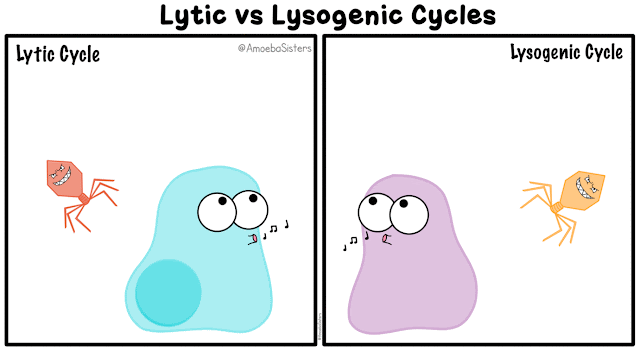 |
| Viruses |
 |
| Injection |
It is the reproduction cycle of virulent bacteriophages, e.g. T- bacteriophage. This cycle ends with the lysis and death of the host cell.
§ Lysogenic cycle
Viruses which do not cause lysis and
death of host cell are called temperate or lysogenic phages. In lysogenic
cycle, the phage remains latent (inactive) and the viral DNA becomes a part of host
(bacterial) DNA which is referred to as prophage.
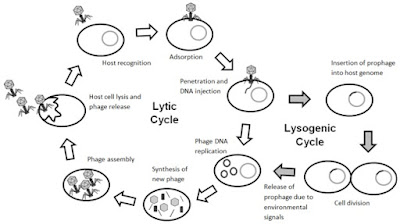 |
| Lysogenic-lifecycle |
Satellite viruses
these were discovered by Karsanin in 1966.Satellite viruses or incomplete viruses are small RNA molecules. Most satellites are associated with plant viruses, but a few are associated with bacteriophages or animal viruses also.
Viroids
These were discovered by T Diener, in 1971. Viroids are small, circular, single-stranded RNA molecules that are considered as the smallest known pathogens. These range in size from 246-399 nucleotides. Viroids cause a number of important plant diseases and can have a severe agricultural impact. E.g. citrus exocortis viroid (375 nucleotides) and potato spindle tuber viroid (359 nucleotides).§ Viroids differ from viruses in two respects
(i) They lack virion like dormant phase
(ii) Genome is much smaller
§ Virusoids :
Small circular RNA molecules needs helper
called virusoids, were discovered by JW Randles in 1981
These are sub viral particle (non- self
replicating)
Virusoids are similar to viroids in
respect to size and circularity but replicate only as genomic part of a plant
virus.
§ Prions:
-
Coined by Stanley Prusiner (1982)
-
Infectious protein particles (without N.A.)
-
Contain Prion protein (PrP)
-
Resistant to heat, ray and chemicals.
-
Sensitive to protease.
LICHENS:
-
These are group
of plants formed by close association of Algae (Phycobiont) and Fungi
(Mycobiont).
-
Phycobiont :
mostly Green algae (Protococcus, Trebouxia, Cytococcusetc) and BGA (Nostoc,
Stigonema etc)
-
Mycobiont :
Mostly Sac fungi/ Ascomycetes, sometime Basidiomycetes.
-
Cosmopolitan,
green bluish colour, sometime- yellow, brown, orange, black etc.
-
Fungal body
covered over Algal body.
3 type-
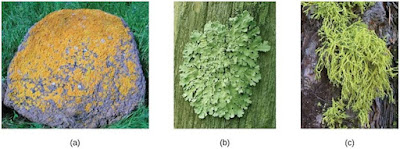 |
| Lichen |
-
(a) Crustose
Lichens: (closely appressed to substrate and
form crusts, thallus flat and without lobes. Eg- Rhizocarpon, Strigula
etc.)
-
(b) Foliose
Lichens: (well branched leaf like, Rhizoids
like Rhizines present for attachment with substratum, eg- Parmelia, Collemaetc)
-
(c)
Fructicose Lichens : (Shrub like
appearance, branched, erect thallus, attach to substratum by a basal disc ,
e.g.- Alectoria, Cladoniaetc)
-
Reproduce by –
Asexual and Sexual Reproduction (Like Fungi).
Economic Importance –
-
Pollution indicator
-
Pioneers in plant
succession
-
as food
-
as medicine
(antibiotics)
in perfume and cosmetics industry.
Want to know about Angiosperm, Click the Link below:
https://uksirnotes.blogspot.com/2022/10/Angiosperm-Monocot-Dicot-uksir-notes.html
Want to know about Kingdom of Plantae Gymnosperm , Click the Link below:
https://uksirnotes.blogspot.com/2022/11/gymnosperm-cycas-uksir-notes-diversity.html

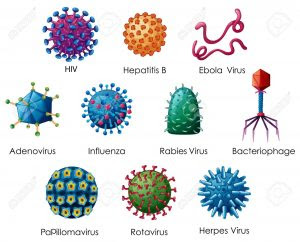

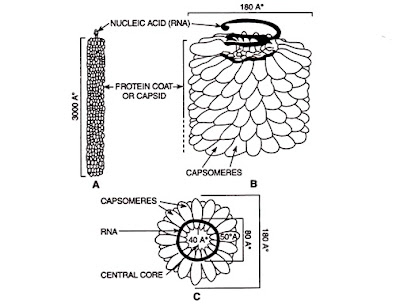
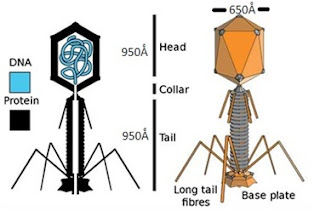
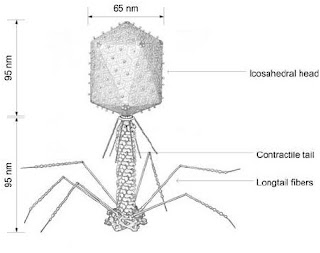
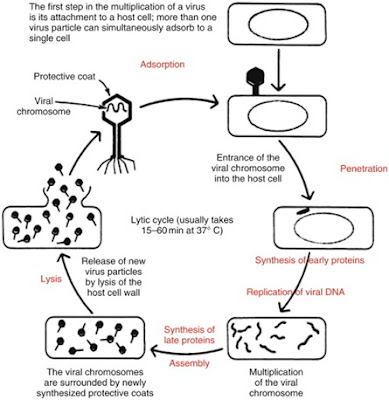




No comments